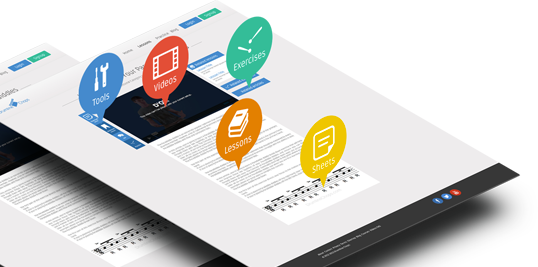Ear Plugs are something that every drummer and percussionist should own and wear regularly.
If you aren’t convinced, you will be after reading this article because there are things in here that will blow your mind.
Okay, maybe not
completely blow your mind...but you should read this article because whether you play marimba, snare drum, drum set, bass drum, or vibraphone, wearing ear plugs is an absolute must to protect your hearing.
Here’s why:
The Anatomy of Your Ear
Your ears have multiple parts to them that are critical to gathering the sound around you and filtering it for your brain to interpret.
The outer part of your ear is called the Pinna or Auricle. This part of the ear acts as a net to catch sound waves around you and funnel them into the ear canal.
#FunFact: The ear canal is where Earwax is produced. As weird as you think earwax may be, it actually protects the ear by containing chemicals that fight off harmful infections inside the ear.
The
Middle Ear is where the gathered sound waves are converted to electrical signals that your brain can recognize.
When the sound waves funnel into the canal they hit the eardrum which contains the three smallest bones in your body including:
- Malleus - means “hammer” in Latin and is attached to the eardrum
- Incus - means “anvil” in Latin and is attached to the Malleus
- Stapes - means “stirrup” in Latin, is the smallest bone in your body, and is attached to the Incus.
Reading through the descriptions of each, you can tell that the eardrum and the bones within the eardrum act as a chain reaction.

As soon as the sound waves hit the eardrum, they cause the eardrum to vibrate the same way your drumhead vibrates when you hit it with a stick (talk about a perfect analogy). When the eardrum vibrates it causes the Malleus to move, which causes the Incus to move, which causes the Stapes to move.
The entire purpose of the Middle Ear is to convert the sound waves to vibrations (hence all the hitting and motion happening within the eardrum).
Once the “sound” reaches the end of the Stapes it is officially a vibration and enters the Inner Ear via the Cochlea.
The Cochlea is a curled tube filled with liquid and lined with tiny cells and hairs called
Stereocilia. When the vibrations from the Stapes hit the Cochlea, the liquid is set into motion like a wave and moves the Stereocilia. Each set of Stereocilia is responsive to a certain type of vibration (pitch) and when they are moved by it, they convert the vibration into an electrical signal and send it to your brain to process.
When your brain processes the electrical signals it receives from your ear - you hear!
Why Drumming Without Ear Plugs is Dangerous
It doesn’t take a genius to realize that drums are loud.
The loud sounds from percussion instruments create intense ripples within the Cochlea where all of those little Stereocilia hairs are.
When your ears are exposed to these intense sounds the Stereocilia become overstimulated. When the Stereocilia become overstimulated they actually die and stop working.
And unlike the hair on your head, Stereocilia never grow back.
In other words: when they die it’s permanent.
Now remember, there are only a few Stereocilia per pitch in your ear. So if you listen to the same loud pitch or combination of pitches over and over again, all of those Stereocilia will die and you will no longer be able to hear that pitch.
Crazy - right?
This is called
Noise-Induced Hearing Loss (NIHL) and is an irreversible disorder.
And just to skip out on all the science lingo for a minute, here’s an eloquent translation of the entire concept into Caveman terms:
“Too much boom boom equal no more boom boom.”
Ear Plugs Prevent Hearing Loss for Drummers
Now that you know how the ear works, how hearing loss occurs, and why hearing loss is inevitable for drummers who don’t take appropriate measures to prevent it...let’s talk about what you need to do to save your hearing.
As a drummer, there are only two ways to prevent hearing loss:
- Always play super soft (never louder than a piano dynamic marking)
- Wear earplugs
And when we look at these two options, we must admit the obvious...
Rim shots are too addicting for #1 to ever work.
So - wear ear plugs. It’s that simple.
Types of Ear Plugs for Drumline
There are hundreds of different types, colors, and styles of ear plugs on the market but there are really only 3 that are viable options for drumline.
One of the most important things you want to look at when selecting ear plugs (regardless of the type of ear plugs) is the Noise Reduction Rating or the NRR. Here’s a quick guide for the numbers:
- NRR 9 - 14 is Low
- NRR 15 - 24 is Medium
- NRR 25 - 35 is High
1) Foam Ear Plugs
Foam ear plugs are the cheapest option and are easy to find. They’re almost always sold in bulk and can be found at your local pharmacy or hardware store.
To use them, you simply put them between your thumb and index finger, apply slight pressure, and roll them back in forth to compress the foam. Compressing the foam allows you to easily insert the ear plug into your ear. Once it’s there, the ear plug will expand to perfectly fit the shape of your ear canal and you’ll be good to go.
Foam ear plugs are disposable so they’re not meant to last a long time. That being said, the length of use depends on you. I personally know people who lose them after a day of use and others who manage to use the same pair every day for a month.
For rehearsals it doesn’t really matter what color you chose (always check with your instructor first) but for shows you should have ear plugs that are a neutral color so they don’t cause a distraction for the audience.
These are great foam ear plugs and work great for drumline
If you want more options check out the
Ear Plug Superstore.
2) Plastic Ear Plugs
Plastic ear plugs are very inexpensive but are often sold in a single set. You can typically find them in your local pharmacy or hardware store but it may take you a few stores to find them since they’re usually not stocked as heavily as foam ear plugs.
The nice thing about plastic ear plugs is that they’ll last you longer than foam ear plugs. If you take care of them, they can easily last you a year. They usually come with a small carrying case or a chord that connects the pair so you don’t lose them.
It’s recommended that you get a pair with the small carrying case because the cord can be a distraction in shows. Or if you really like the cord, get a second pair without it for show days.
These are great plastic ear plugs for drumline
3) Musician Ear Plugs
These are amazing.
They’re more pricey than the foam and plastic ear plugs, but they are well worth every penny if you’re in drumline rehearsals multiple times a week.
One of the most popular brands for musician ear plugs is
Etymotic Research.
They’re custom molded to your ear canal so they fit in your ear perfectly and comfortably. They also have special music filters that allow all of the frequencies to enter your ear - just at a reduced volume. This means everything sounds extremely natural, just quieter.
To get these, you’ll need to make an appointment with an ENT (ear, nose, and throat) doctor. They’ll take the molds of your ear canal, send them to the company, and get them ordered for you.
You can also swap different filters in and out. So if you’re drumming inside and want more protection you can put in a 25 decibel filter. If you’re drumming outside and want a little less you can put in a 15 decibel filter, etc.
These are great musician ear plugs for drumline.
* I personally own these and have had the same pair for over 7 years and wear them almost daily if that gives you any indication of how much I like them!
What Type of Ear Plugs Should I Use at Drumline?
Honestly, any of the three options above will work. What’s important is that you USE ear plugs and that you use them REGULARLY.
Wearing a super cheap disposable foam ear plug EVERY rehearsal is FAR better than wearing more expensive musician ear plugs once every 3 rehearsals.
If you don’t usually wear ear plugs to practice or if you don’t wear them regularly, I recommend that you start off by getting a box of foam ear plugs. Get in the habit of wearing them every single rehearsal and keeping track of them before and after you use them.
Once you’ve done this for a few months and have formed a good habit of using them, get a pair of plastic ones. After you continue to use them every rehearsal and take care of them, upgrade to the musician ear plugs.
I believe this is the best way to go because if you aren’t used to wearing ear plugs every rehearsal, you’re certainly not used to taking care of them and keeping track of them.
There’s nothing worse than spending money on a nice set of musician ear plugs and then losing them after a week because you thought you put them in your pocket but now you can’t find them...
Keeping track of your ear plugs is a habit that needs to be created just like wearing them every rehearsal!
“But Ear Plugs Make Everything Sound Different and Make it Hard to Clean”
Get over it.
The people that say it’s harder to play clean when wearing ear plugs are the same people that wear them once, get weirded out by the change, and then don’t wear them again for 6 months - of course you’re going to hate them.
If you don’t wear ear plugs consistently, you’ll never feel comfortable wearing them.
Start wearing them to every rehearsal and you’ll quickly learn how to play with them to the point where you forget they’re there.
Yes - your listening situation will change a little bit when you wear ear plugs. However, you will adapt and learn what “clean” sounds like with them and all will be good in the world.
The Bottom Line of Wearing Ear Plugs
Percussion instruments can cause significant hearing loss and hearing loss is an irreversible (read permanent) condition.
To prevent hearing loss, you need to wear ear plugs when you drum.
It doesn’t matter what type of ear plugs you wear. What matters is that you own ear plugs and wear them to every practice session, rehearsal, and show.
If you don’t currently wear ear plugs on a regular basis, it will take some time to become comfortable with them but the only way to do that is to start wearing them consistently.
Despite how “uncool” you think it is to wear ear plugs now - you will be thankful 20 years from now when you can still hear everything going on around you.
Don’t be that guy who says, “I don’t need ear plugs, they’ll have replaceable ears by the time I go deaf!” because there are plenty of drummers who convinced themselves of that and are wishing they could hear now...but those “replaceable ears” are nowhere in sight.




